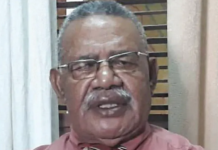
By Thomas Leaycraft of Scoop
The “window of possibility” for less than 2 degree C temperature rise will close in the next 10 years, says Victoria University’s Dr Tim Naish, a keynote speaker at today’s In the Eye of the Storm Pacific Climate Change Conference.
Naish, a professor of glaciology, and Professor James Renwick of Victoria’s School of Geography and Environment and Earth Sciences, presented empirical evidence on the long and short-term implications of climate change.
Professor Renwick began the presentation, focusing largely on the consequences of the warming air.
 ”We’re going to see climate change for quite a long time yet regardless of what we do.”
”We’re going to see climate change for quite a long time yet regardless of what we do.”
Carbon dioxide concentration had “rocketed up in recent years”, and temperatures were correspondingly reaching historic heights.
The future held more extreme weather, explained Renwick. “The wet will get wetter and the dry will get drier.”
The weather patterns many nations relied upon for rain would be disrupted, and the warm air would carry more water, leading to more flooding and severe storms.
Oceanic temperature rise
Perhaps more significant than the atmospheric temperature increase was the oceanic temperature rise.
As 93.4 percent of warming occurred in the ocean, Renwick explained, this particularly affected the Pacific.
Even slight changes in temperature had extreme impact on aquatic microorganisms and corals that supported the aquatic food chains, and thus the fishing industry.
However, Renwick explained that perhaps the greatest consequence of the warming seas was glacial melting, which “is going to cause us all a problem around sea level rise”.
At its current trajectory, temperatures would rise by 4 or 5 degrees this century, although a potentially “unimaginable climate” could develop, with an average temperature rise of over 10 deg C and glacial meltdown.
Dr Renwick’s coworker, Professor Naish spoke more on the potential for catastrophic glacial meltdown during the second half of the presentation.
“We really don’t have a good handle on what the ice sheets are going to do… if they do something unpredictable, ‘all bets are off’.” Some research, said Dr Naish, even suggested that runaway glacial melting had already begun.
Long-term impacts
Professor Naish then launched into the long-term impacts of the melting glaciers and rising sea levels on the Pacific. As he explained, areas farthest from a melting ice sheet saw the greatest sea level rise, so the rapidly melting Arctic, where average temperatures were sky-rocketing, would have the greatest effect on the South Pacific.
“The Pacific will get up to 10 percent more sea level rise than the global rise,” said Naish; a total meltdown of all of earth’s glaciers at both poles could mean 20 or more metres of sea level rise.
The Pacific Islands nations were among the most vulnerable in the world to catastrophes of this nature.
Naish explained that such countries typically lacked the resources to brace against the coming seas and prepare for increased flooding.
In many places one-in-100-year flooding was becoming an annual event. These floods were catastrophic, grinding tourism to a halt, tainting water supplies, destroying homes and infrastructure, and damaging soil fertility.
Avoiding a drastic rise “requires very invasive mitigation and potentially the removal of CO2 from the atmosphere,” said Professor Naish, and should involve assistance for those island nations most effected by this crisis.
“Sea level rise will continue for thousands of years based on decisions we’ll make on mitigation over the next few decades.”
Thomas Leaycraft is a Scoop student journalist intern covering the In the Eye of the Storm conference for Scoop, Asia Pacific Report and Evening Report.
Read more about the In the Eye of the Storm Pacific Climate Conference.
<div class=”storify”><iframe src=”//storify.com/pacmedcentre/climate-change-2015/embed?border=false” width=”100%” height=”750″ frameborder=”no” allowtransparency=”true”></iframe><script src=”//storify.com/pacmedcentre/climate-change-2015.js?border=false”></script><noscript>[<a href=”//storify.com/pacmedcentre/climate-change-2015″ target=”_blank”>View the story “Climate change 2016” on Storify</a>]</noscript></div>














































